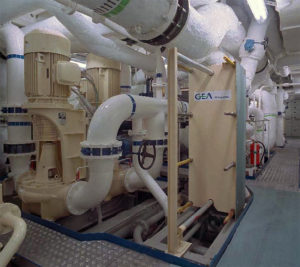

Ships, both cargo and cruise ones, have several thermoregulation needs, usually achieved with plate heat exchangers. It involves those which are usually called ‘central cooling’, that ensures in first place the cooling of the engines, and secondary supplying freshwater for the cooling of all the utilities on board.
Big engines driving modern ships need indeed to be cooled, as for every other kind of endothermic engine. Being the ship sailing in the mid of the most efficient cooling fluid available, seawater, the trick here is that the cooling system is yet ready and available to be employed. Seawater, rich in chlorides, is an excellent and low-cost cooling fluid. Anyway, due exactly to its salinity it requires the use of special corrosion resistant materials. In the past, huge shell and tube exchangers were commonly employed for this kind of application, made in copper-nickel (also called Admiralty brass), an alloy resistant against the corrosion caused by salts in seawater. These exchangers also had to be easy to clean, because seawater, despite of filtering, is full of sediments and micro-organisms. These were then usually straight tubes exchangers with removable heads, ensuring easy cleaning operations.
These are excellent thermal exchange equipments with quite low thermal transfer coefficients, that then required quite important sizes and also appropriate nearby spaces to permit rods cleaning operations. And on ships, space is a precious asset, and especially within the engine room the more space can be saved, the better.
This kind of exchangers has then been replaced nearly completely by modern inspectable plate heat exchangers. They offer indeed a series of advantages, making them irreplaceable in this kind of application:
A plate heat exchanger offering the same thermal performance of a shell and plate exchanger presents indeed much more compact dimensions, and doesn’t require nearby spaces for rod-cleaning maintenance operations required by the tube exchanger. A plate heat exchanger can indeed be mounted and dismantled only using the footprint of its framework, and just a narrow space on its side to potentially remove the plates (the normal access area required by any kind of equipment). The overall thermal transfer coefficient of a plate heat exchanger is approximately 4 times higher compared to a tube exchanger. Plate heat exchangers aimed for seawater applications are made in titanium plates, a material that offer extremely high corrosion resistance against chloride, thus not requiring any anti-corrosion exceeding thickness. And overall this even has a lower cost compared to a copper nickel shell and tube exchangers with equal thermal characteristics.

Always speaking of diesel oil or heavy fuel oil engines, typically marine engines employed on mercantile ships, cruise ships and ferry-boats, heat exchangers are also used for the pre-heating of the fuel oil that supplies endothermic engines. This kind of applications employs brazed plate exchangers, usually quite small ones, fed by low pressure vapor (3-4 bars) in order to pre-heat the fuel even up to temperatures of 100° C, ensuring that the fuel oil is fluid enough when it arrives to injectors.
Anyway, a modern ship is also equipped with a whole series of hydraulic drives, served by hydraulic units:
All these applications employ the oil as a power element and a transmission media for the energy, which is then heated and therefore must be constantly kept at a proper temperature not to loose its working properties. Once again, plate heat exchangers are utilized for this kind of applications, nearly always brazed plate exchangers type, due to their compact size and the high thermal transfer efficiency, in addition to their low-cost.
At last, there are also electric panels, drives and electronic components such as inverters, inductors and converters, very often installed in narrow and scarcely ventilated areas, which all need dedicated cooling systems. The combination water and electronics is surely puzzling, but the harsh working conditions and the high rates of heating involved cannot be managed using contact-mounted finned dissipators similar to those employed for PCs. Air cooling here is not an option, and therefore water cooling must be adopted as well. Here, water is pushed flowing directly within the electronic power components using dedicated closed path circuits.
The water employed here is usually deionized or demineralized water, and in any case it must be perfectly filtered, avoiding any possible soiling and clogging of the components’ closed path cooling circuit. Hence, this package cooling systems are made in stainless steel of plastic material, and they are always coupled with plate exchangers, which transfer the heat to the cooling fluids. Cooling fluid, based on the kid of applications, can be supplied by:
The whole system is managed by temperature regulators that command the inlet valves of the refrigerating water, based on the defined set-point.